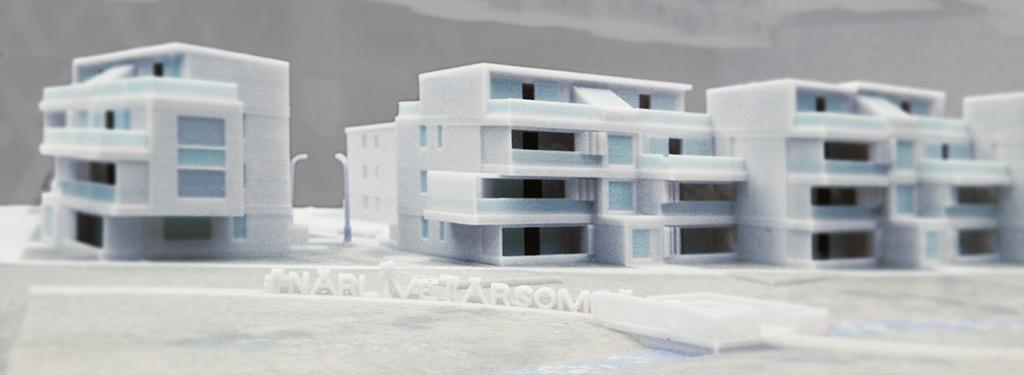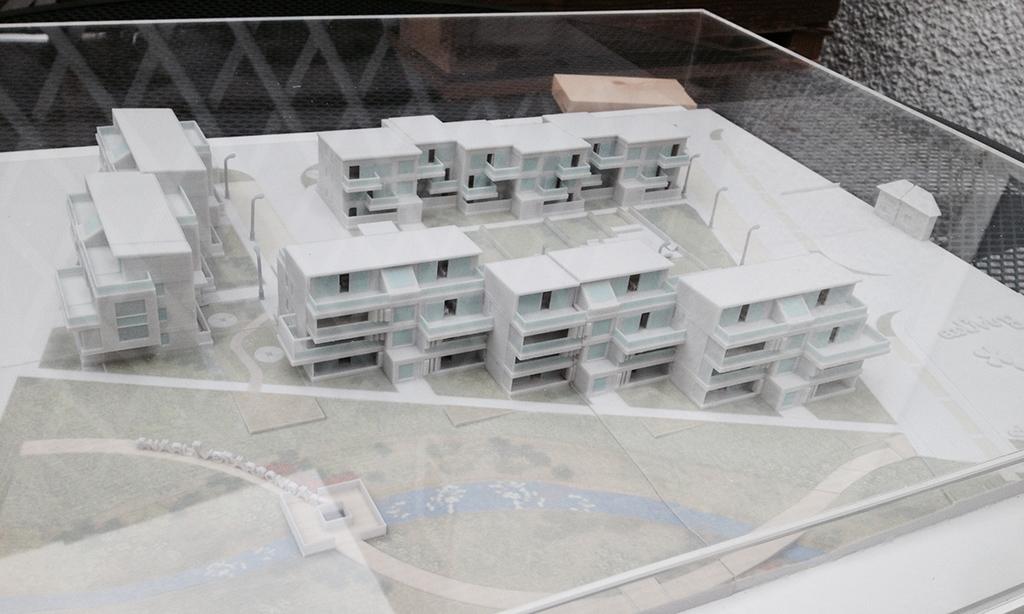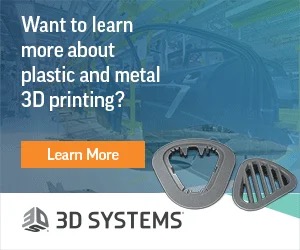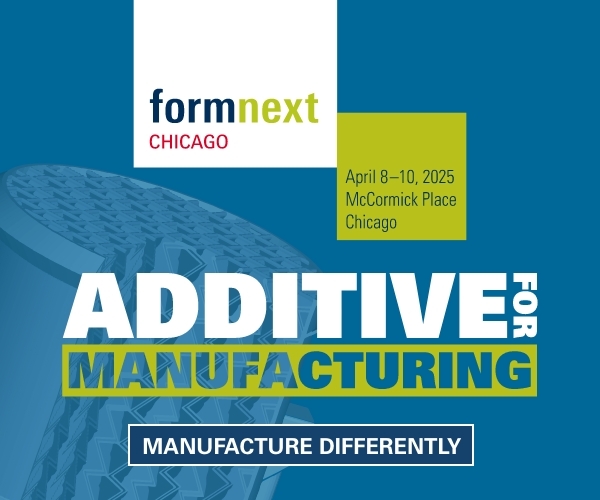London-based architect, David Weatherhead of Weatherhead Architecture, Ltd., was formerly a skeptic of the benefits of 3D printing in the architectural design process. He regarded model-making as a necessary step but one typically outsourced to professional model makers to save time. When Weatherhead began running his own practice, he admits he had to rethink his approach on many fronts. “I had to evolve my skills,” he wrote in a recent blog. “With time always escaping me, the decision was made to explore technology and see what it can do for me.”
Weatherhead decided to try 3D printing of a model for a housing project his firm designed in Sweden called Skummeslövs Ängar. The scale he selected for the model was 1:250, which he regards as “kind of in-between being detailed and concept.”
To create his 3D-printed model from his design, produced in ArchiCAD, Weatherhead engaged Hobs Studio in London. Hobs offered him two different 3D-printing options. According to Weatherhead, the first involved, “a layering system using fine powder. The plan shape builds up through 1mm printed layers.” Weatherhead felt this process produced a model that was not as refined as he preferred. The second process, explained Weatherhead, entailed “a clear liquid bath and some lasers.” In essence, he continued, “the lasers solidify the area that needs it, and the model literally rises up from the liquid over time.” The drawback with this process for Weatherhead was that the resulting model was clear, although 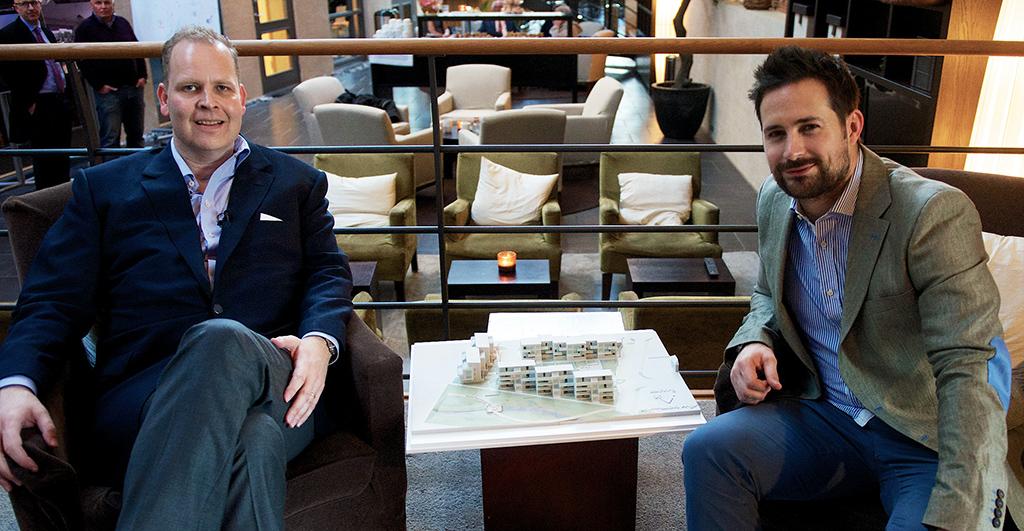 smoother than the first material. Both processes were priced nearly identically. After weighing his options, the architect decided on the first process and the cost was within his firm’s budget.
smoother than the first material. Both processes were priced nearly identically. After weighing his options, the architect decided on the first process and the cost was within his firm’s budget.
Weatherhead ran into a problem because he had an outdated version of ArchiCAD. After updating to ArchiCAD 17, which allowed him to provide Hobs Studio with an .STL file, the project moved forward and Hobs responded quickly with a screen shot of the converted model.
The next snag, for Weatherhead, was that the 3D-printing process at the scale he desired would make it impossible to print a simulation of glass. Hobs offered to print areas that were designated as glass in color, as the model would have been too delicate with those spaces simply left open. The architect feared that the colored effect would produce a model that looked, in his words, like a “toy town,” an end result he balked at.
Weatherhead opted to produce a test print, which he offered to pay for out-of-pocket. In a gesture of goodwill (and astute salesmanship), Hobs printed one element of the model in color. In the end, a kind of compromise was reached and the model was printed with the glassed-in areas open, literally–explained Weatherhead, “Since the model was going to be printed with the glass solid I decided to open up as many of the glass sliding doors as possible to further give the impression that these elements are glass.” He also adjusted the design so that he could “show interior furniture,” an extra step that was actually quite simple.
With the problem of the buildings–particularly, the windows–resolved, Weatherhead adjusted his design to add color to the landscape, providing details such as shrubs, plants, and flowers. He described this fairly simple step, “I then worked on this in Photoshop and muted the color a little. I removed the background and saved [the file] as a transparent .png file. I then sent this, at the right scale, to Hobs and they added the changes to the virtual model.” Hobs refined the final model, which included deleting any excess material to reduce cost.
Weatherhead was surprised to discover that it took “less than a day” for Hobs Studio to print the final, 3D model. He also requested a display case and a case for transporting the model to Sweden. Ultimately, the architect was happy with the end result, although he would alter the finished model’s windows. He admitted in his blog that he was now embracing this new process for creating 3d models, writing, “I’m also really happy I didn’t spend a solid day cutting 2D sections and elevations and spending time explaining the contours of the landscape…So many times I have had models made and you receive [them] only to discover loads of things which were lost in translation. As an architect, I hate this more than anything; it’s a bit like picking up the wrong baby from the hospital.”
Subscribe to Our Email Newsletter
Stay up-to-date on all the latest news from the 3D printing industry and receive information and offers from third party vendors.
You May Also Like
NSF Awards Kentucky $1M for Advanced Manufacturing
The National Science Foundation has awarded a $1 million grant to the University of Louisville for the Advancing Manufacturing and Building Construction Technologies (NSF AMT) project. This initiative is part...
3D Printing News Briefs, May 11, 2024: 3D Printed Stent, Tower, Sculptures, & More
We’re starting off with medical research in today’s 3D Printing News Briefs, as researchers in Korea used CT images and 3D printing to fabricate an educational simulator for a mastoidectomy....
3D Printing Unpeeled: Wind Turbines, Probiotics and Lenses
TPI Composites, ORNL and Ingersoll Rand are working to make wind turbine tooling segments that can be 18.3 meters long. These elements also include resistive wires that help keep the...
Tethon 3D Releases Cost-effective Bioprinter
Tethon 3D, known for its ceramic-loaded DLP materials, custom resins, and DLP 3D printers, has recently released a bioprinter. Vat polymerization printers like DLP systems have been widely used by...


